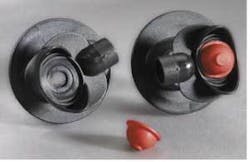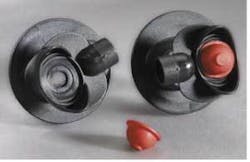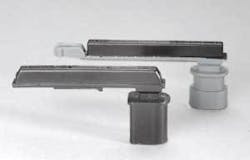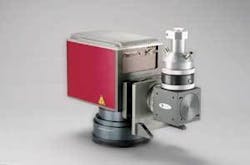Welding plastic
For plastic welding high-power diode lasers offer high efficiency and compact design
Klaus Kleine, Andre Eltze, and Michael Nagel
High-power diode lasers are established in a large variety of application areas such as: polymer welding, hardening, glazing, heat-conduction welding, cladding, and brazing. Due to their modular set-up, the versatile diode lasers can deliver the laser beam to almost any geometry. A line or rectangular geometry of the focus is best suited for large-area polymer welding or multi-laser concepts, and round focus geometry is used for all other plastic welding applications where a maximum of flexibility and reliability is requested.
As an alternative to the traditional plastic-joining procedures such as ultrasonic welding, vibration welding, or heated-tool welding, diode lasers in combination with a galvo scanning system can be used to weld almost all thermoplastics. Thermoplastics can be joined quickly and reliably with this procedure, which, to a large extent, is independent of the dimensions and layout of the weld area. Also, damage to electronic components or contact pins can be avoided. In contrast to ultrasonic welding there is no limitation on part size and “soft/hard” polymer combination (see Figure 1) can be joined. In addition weld flash is small and totally fluff free.
Diode lasers now provide state-of-the-art solutions in volume production of pressure-tight welding seams for containers, electronics housings, automotive parts, and foils.
Increased productivity
Plastic welding with higher process speeds and thus higher productivity can be achieved using the new generation diode lasers with higher power.
Experiments for plastic welding with diode lasers have shown that for certain material combinations, dyes, and material thicknesses the linear energy requirements are nearly constant. Doubling the laser power means that the process time to weld a plastic component is reduced by 50 percent. This concept works in a large process parameter space and is only limited by the absorption properties and the thermal behavior of the polymeric materials: If the linear energy is too high, the translucent top material starts to absorb and can be damaged. On the other hand, if the linear energy is too low, at high process speed the interaction of the laser beam with the process area can result in insufficient weld performance.
An application example (see Figure 2) is the welding of electronics housings with a weld length of 250 mm. The material is PA, with a thickness of 1 mm. With laser transmission welding it is necessary that one of the joined parts is translucent for the laser wavelength. The second part needs to absorb the laser energy in order to transfer the laser radiation into heat. The housing contains black dye to absorb and the cover is translucent for the laser radiation. Therefore the absorption of the laser radiation happens only in the boundary area. Both parts are pressed together and heat input in conjunction with thermal conduction leads to melting of both materials. After the solidification of the melted polymers the parts are joined.
The quasi-simultaneous welding process with the DioScan (see Figure 3) diode laser system from Laserline was used for this process. A scanner unit connected to the output of a diode laser quickly and repeatedly traces the laser beam over the weld geometry of the workpiece leading to an even heating of the weld area.
Experiments with the diode laser system and scanner combination at power levels between 80 and 350 W show a direct relationship between laser power and productivity.
The contour was welded by 60 passes with 160W laser power at a scanning rate of 1.5 m/s within 10 s. It was possible to reduce the process time successfully using the higher laser power: With an output of 350 W a given weld seam can be welded with a process speed of approximately 3.3 m/s. The weld quality is nearly unchanged compared to lower processing speeds. In this case, the linear energy changes only slightly and the total welding time can be reduced to less than 5 s (see Figure 4). Altogether, an increase in productivity was feasible as a result of higher laser power levels.
Flexible laser beam sources with higher power are needed to take advantage of this relationship so that the welding speed can be scaled. The systems used for plastic welding are often direct or fiber-coupled diode lasers, where the weld seam is traced once with the laser beam. Multiple lasers are used in simultaneous welding, where several lasers process the same part at the same time simultaneously.
The advantages of both multi-laser systems and single laser systems can be combined in a system like the DioScan. Within milliseconds, two mirrors point the laser beam to any point in the working area of 10 in. x 10 in. Focal sizes and hence weld seam widths down to 0.02 in. can be reached. This system allows for great flexibility in weld contours and shapes, and can be used up to large weld sizes if required. Laser power levels of up to 1000W allow for high weld speed and quick adaptation to new and complex weld geometries without mechanical movement of the part or the laser head.
Main application areas are contour welding and quasi-simultaneous welding. The advantage, compared, for example, with ultrasonic welding, is that the parts are not deformed, and that fragile parts can be welded without mechanical contact.
Even without the use of 3D scanners, it is possible to produce a part with a weld seam that does not lie in one plane. This is done by exploiting the good depth of field, particularly with longer focal lengths. Even at the relatively short focal length of f =163 mm a depth of field (change of focal diameter less than 10 percent) of 15 mm is achieved. Therefore, workpieces that are uneven or show deviations in the range of 15 mm from the focal plane can be processed with uniform results. At longer focal distances the tolerances are even greater. Experiments in the lab confirm that statement for many uneven or three-dimensional parts.
Flexible, economical, scalable
To summarize, the non-contact and rapid diode laser plastic welding process offers a flexible and wear-free alternative to conventional plastic welding processes: vibration welding requires rigid and expensive tooling, hot plate welding, which causes severe thermal stress, and ultrasonic welding, which has only restricted suitability for large parts. The short process time and the localized energy of diode laser welding reduce stress in the plastic parts. Highly sensitive electronic circuits in the workpiece are not damaged during the welding process. Weld splatter from the joint can be avoided or controlled by optimizing the selection of materials and dyes. A large number of material and color combinations can be successfully welded at the desired bond strength.
Diode lasers are characterized by their efficiency and compact design. Their higher efficiency leads to low investment and operating costs. High up-time performances of diode lasers have been demonstrated in many mass production applications. Recent developments such as faster shutters and stack management have increased the laser up-time to more than 99 percent.
Diode lasers with scanners are successfully used in automotive mass production for sensor housings, containers, electronics parts, liquid tanks, and hydraulic components. In the medical device industry, they are used for welding foils and bonding fluid containers.
The increased productivity at higher laser powers is particularly useful in applications with long weld seams. For example, a doubling of the weld seam length is compensated by doubling the laser power, holding the total process time approximately constant. Thanks to their modular design, diode lasers can be easily adapted in power to accomplish a new task or function. This capability can increase the productivity without major changes to the plant as a whole.
Klaus Kleine ([email protected]), Andre Eltze, and Michael Nagel are with Laserline Inc., Los Gatos, CA.




